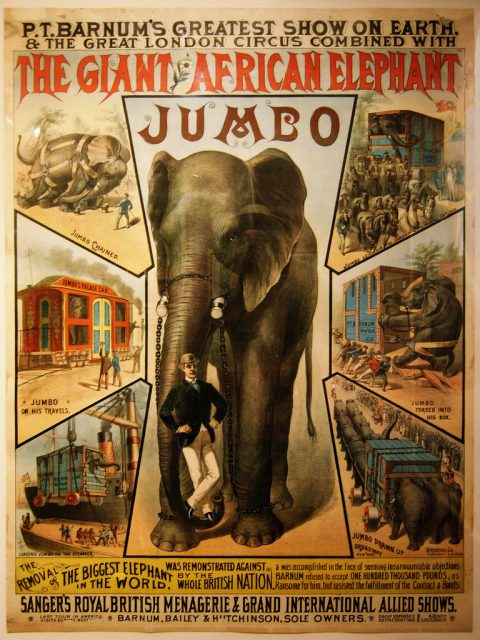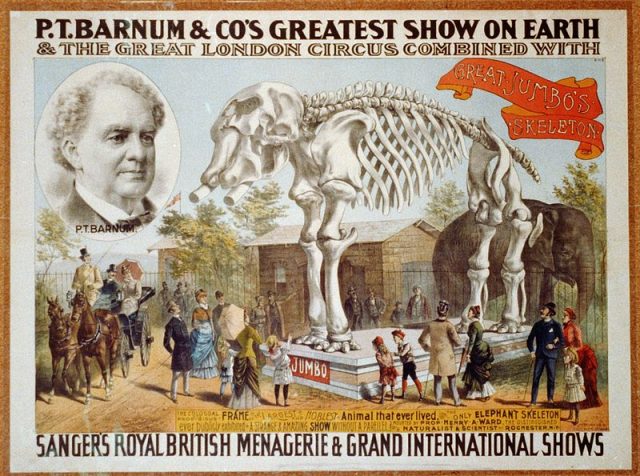
Jumbo was the world’s first animal superstar. There were millions of people who went to see the biggest elephant in the world, first an attraction at the London Zoo and later of Barnum & Bailey Circus. He was the most adored animal of the time, and yet his story is a tragic one, for he ended up being killed by a train when he was only 24. Jumbo was a unique elephant about whom many books have been written, the most popular by his keeper and lifelong friend, Matthew Scott. It is also supposed that he was the inspiration for Disney’s Dumbo.
Jumbo was born in 1860 somewhere near today’s border between Sudan and Ethiopia. When he was only two, his mother was killed by hunters in Sudan. Jumbo was captured and sold to an Italian animal dealer, Lorenzo Casanova, who was transporting African animals. The little elephant lived first in the Paris zoo, Jardin des Plantes, until 1865, when he was bought by the London Zoo, where he got his name Jumbo. Although it is not clear what was the meaning of the name Jumbo, whether it was a variation of “Jumbe,” the Swahili word for “Hello,” or something else, it is certain that the word Jumbo became a synonym for something big.
At the time, people were eager to see and learn more about species of African wildlife. Although many were familiar with Asian elephants, the African ones were bigger and less common, and Jumbo was quite a sensation. He was given to Matthew Scott, a bachelor in his early thirties who seemed to have stronger bonds with animals than with people. The two got along and eventually became best friends. Quite often Scott slept in his friend’s stall after the two of them would share a bottle of scotch. Yes, Jumbo liked alcohol. Besides the whiskey he shared with Scott, Jumbo liked a keg of beer during the day.

Poster of Jumbo the Elephant
Jumbo grew to almost 11 feet and weighed five tons, and sparked everyone’s curiosity. People loved him, especially children who rode on his back in a huge howdah. Winston Churchill and Theodore Roosevelt were among many children who rode on Jumbo’s back. However, the elephant, although sociable, wasn’t enjoying his life in the zoo. He hurled himself against the walls and broke both his tusks, and when they regrew, he ground them down. Much of his behavior couldn’t be understood back then, and people feared that Jumbo was becoming aggressive, even though his unpleasant behavior occurred mostly at night when he was alone in his quarters. David Attenborough, the author of the documentary about Jumbo’s life, said that he was a “Jekyll and Hyde character.”
Fearing that he might hurt someone, Abraham Dee Bartlett, the superintendent of London Zoo, believed that the only solution left was to shoot the elephant. He also feared that Jumbo, aged 16 in 1881, was reaching elephant adolescence which came with his first outbreak of “musth,” a rise of testosterone which occurs annually and triggers bull elephants to mate. Their anxiety was over what spectators could witness in an aroused elephant.

Poster of Jumbo’s skeleton
Luckily, an offer came from P.T. Barnum, who offered £2,000 for Jumbo to the London Zoo, so in 1882 the elephant was sold to the Barnum & Bailey Circus. It seemed that no one except for Bartlett was happy with the decision. There was public objection, with more than 100,000 people writing to Queen Victoria begging her to prevent the sale. But the deal was done, the elephant was sold, and despite the Queen’s objections and a lawsuit against the zoo, Barnum refused to sell Jumbo back.
The transport to New York was a very traumatic experience for Jumbo. He appeared to have seasickness and could be calmed down only with alcohol. Once he arrived in New York City, Jumbo was exhibited at Madison Square Gardens and was such an attraction that Barnum earned the money he spent for buying the elephant in just three weeks. Jumbo was one of Barnum’s 21 elephants who crossed the Brooklyn Bridge in 1884. He was an attraction presented by Barnum as the biggest elephant in the world. This claim, however, is not entirely accurate, though not necessarily wrong. Jumbo was too young and still growing, as elephants develop until the age of 40. Barnum added to the real size of the elephant. On the other hand, more recent measurements showed that Jumbo was 20 percent bigger than other bush elephants at his age, and he had 16 years ahead to grow. If he lived, he might have become the biggest elephant in the world.

Jumbo statue in St. Thomas, Ontario. CC BY-SA 3.0
But he didn’t. He died when he was only 24 in a train accident that was long suspected to be reckless, if not murderous. The incident happened in 1885, in Ontario, Canada, where the circus was taking place, and by far, Jumbo was its biggest attraction. One night after the show the animals were led back to their train car. To reach it they had to cross a railway line which was said to have been kept clear for the safety of the animals. Jumbo and a smaller elephant Tom Thumb were the last ones, and when they got on the railroad, a freight train thundered towards them. It struck Jumbo and killed him.
Barnum told a story for the newspapers that Jumbo died heroically saving the younger elephant, but eyewitnesses claimed that there wasn’t such an occurrence. Jumbo’s death was covered by media across the globe. Barnum went on making money from Jumbo after he toured with his stuffed skeleton. In his stomach, many unusual objects were found such as English pennies, rivets, keys, and a police whistle. Jumbo’s skeleton was finally donated to the American Museum of Natural History in New York City, where it remains.

Cover of Autobiography of Matthew Scott, Jumbo’s Keeper; also Jumbo’s Biography (1885)
A team of scientists examined the skeleton recently and found that the aggressive behavior of Jumbo was probably caused by terrible toothaches. The alcohol was undoubtedly not helpful.
Jumbo’s only friend, Matthew Scott, continued to live a lonely life, distraught with grief, talking only of Jumbo.
